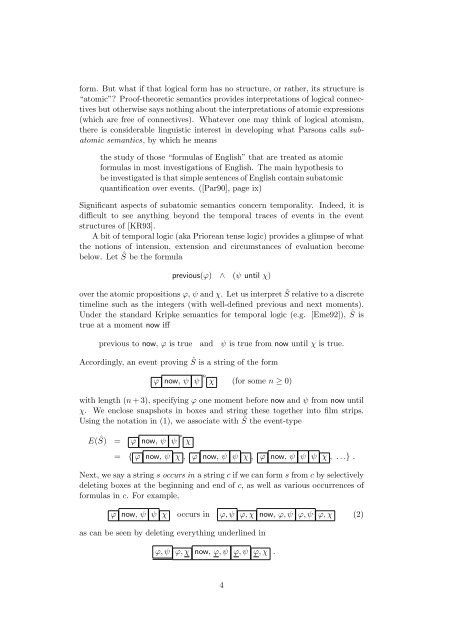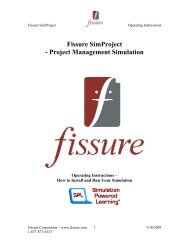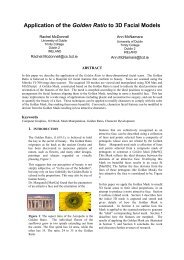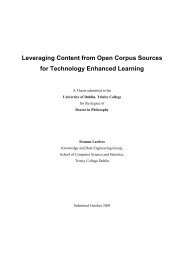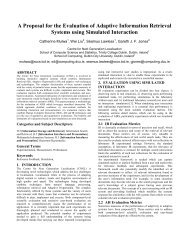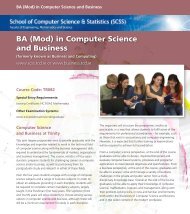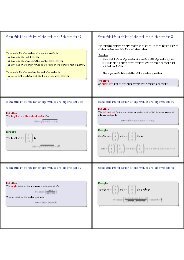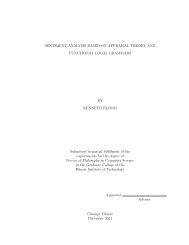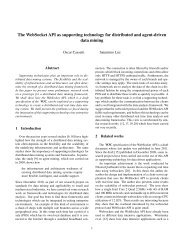Situations from events to proofs 1 Introduction
Situations from events to proofs 1 Introduction
Situations from events to proofs 1 Introduction
Create successful ePaper yourself
Turn your PDF publications into a flip-book with our unique Google optimized e-Paper software.
form. But what if that logical form has no structure, or rather, its structure is<br />
“a<strong>to</strong>mic”? Proof-theoretic semantics provides interpretations of logical connectives<br />
but otherwise says nothing about the interpretations of a<strong>to</strong>mic expressions<br />
(which are free of connectives). Whatever one may think of logical a<strong>to</strong>mism,<br />
there is considerable linguistic interest in developing what Parsons calls suba<strong>to</strong>mic<br />
semantics, by which he means<br />
the study of those “formulas of English” that are treated as a<strong>to</strong>mic<br />
formulas in most investigations of English. The main hypothesis <strong>to</strong><br />
be investigated is that simple sentences of English contain suba<strong>to</strong>mic<br />
quantification over <strong>events</strong>. ([Par90], page ix)<br />
Significant aspects of suba<strong>to</strong>mic semantics concern temporality. Indeed, it is<br />
difficult <strong>to</strong> see anything beyond the temporal traces of <strong>events</strong> in the event<br />
structures of [KR93].<br />
A bit of temporal logic (aka Priorean tense logic) provides a glimpse of what<br />
the notions of intension, extension and circumstances of evaluation become<br />
below. Let Ŝ be the formula<br />
previous(ϕ) ∧ (ψ until χ)<br />
over the a<strong>to</strong>mic propositions ϕ, ψ and χ. Let us interpret Ŝ relative <strong>to</strong> a discrete<br />
timeline such as the integers (with well-defined previous and next moments).<br />
Under the standard Kripke semantics for temporal logic (e.g. [Eme92]), Ŝ is<br />
true at a moment now iff<br />
previous <strong>to</strong> now, ϕ is true and ψ is true <strong>from</strong> now until χ is true.<br />
Accordingly, an event proving Ŝ is a string of the form<br />
ϕ now, ψ ψ n χ (for some n ≥ 0)<br />
with length (n + 3), specifying ϕ one moment before now and ψ <strong>from</strong> now until<br />
χ. We enclose snapshots in boxes and string these <strong>to</strong>gether in<strong>to</strong> film strips.<br />
Using the notation in (1), we associate with Ŝ the event-type<br />
E(Ŝ) = ϕ now, ψ ψ<br />
∗<br />
χ<br />
= { ϕ now, ψ χ , ϕ now, ψ ψ χ , ϕ now, ψ ψ ψ χ , . . .} .<br />
Next, we say a string s occurs in a string c if we can form s <strong>from</strong> c by selectively<br />
deleting boxes at the beginning and end of c, as well as various occurrences of<br />
formulas in c. For example,<br />
ϕ now, ψ ψ χ occurs in ϕ, ψ ϕ, χ now, ϕ, ψ ϕ, ψ ϕ, χ (2)<br />
as can be seen by deleting everything underlined in<br />
ϕ, ψ ϕ, χ now, ϕ, ψ ϕ, ψ ϕ, χ .<br />
4


